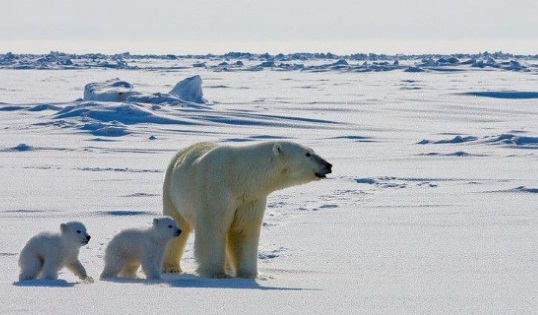Melting ice-caps leads to rising sea levels and potential loss of property. But it won’t necessarily affect our food supply; in fact it will open more land for cultivation – and we can just move or build levees too. It’s not terminal. Sadly for polar bears, loss of sea ice today means starvation. By Jeremy Torr.
Courtesy Daniel-J-Cox UoW
Washington, 12 March 2019. A 2016 study by the Royal Society confirmed that the loss of Arctic sea ice is “the primary threat to polar bears throughout their range.” This, said the study, was because there was a direct relationship between the lifespan of the typical polar bear, and the diminishing amount of sea ice in its habitat, thanks to climate change.
The Society predicted “large declines in polar bear numbers owing to sea-ice loss, and … near-term uncertainty” but didn’t give exact causes though. Most researchers suggest that the correlation is because polar bears need sea ice to help them hunt seals, their main food source. They walk across the ice pack, looking for breathing holes or seal birth dens. When they find one, they sit and wait for a seal to emerge from the freezing water below, then hey presto, it’s dinner time. If there is no ice to walk on, it’s starvation menu for bears.
Polar bears traditionally hunt mostly on the ice shelf. Courtesy PBI International
As Kristin Laidre, a lead marine biologist at the University of Washington (UoW) Polar Science Center, warns: "If the rate of sea ice loss and warming continues … what is going to happen to polar bear habitat will exceed anything documented over the last million years.”
But the question remained, what was the reason for the bears’ rapidly declining lifespans?
As most readers will know, this is not the first time the earth’s temperature has risen over time; there have been previous global warming episodes. Researchers believe that for the past million years or so there have been regular warming cycles at approximately 100,000 year intervals. These have seen some 80-90,000 years of ice age followed by around 10-20,000 years of subsequent global warming. Polar bears have survived these cycles before, apparently without the drastic drop in numbers such as the Royal Society report is predicting.
The answer, according to a recent UoW study, is that human intervention has removed one key alternative food source – dead whales.
Polar bears have been observed feasting on beached whale carcasses. Courtesy Phys.org
The UoW study suggests that polar bears are facing a shortage not just of seals but of carrion too. In previous melt episodes, when their ability to roam across ice floes to hunt and kill seals for food was restricted, Laidre and her team suggest bears fed on dead whales. Every year, many are washed up on newly ice-free shores (also known as whale beaching).
But commercial whaling and anthropocene-era hunting have decimated the whale population in the Arctic. Since the early days of commercial whaling, about 3 million whales are estimated to have been killed in the search for oil bone, and meat. Sperm whale numbers are down 60%, blue whales down to just 10%, and the Right whale and Antarctic Blue whale are almost extinct. So the days of whales swimming (and beaching) in their hundreds on Arctic shores are gone.
As one of the UoW research team, Ian Stirling, points out, the situation today is very different from previous warming eras. “The potential for whale carcasses to bail bears out may still be important in a few areas but, quite simply, (dead whales) overall availability is going to be substantially less than before humans invaded the Arctic," he says.
Dead whales offer young cubs a chance to survive away from the ice floes. Courtesy UoW
Polar bears still tuck into whale carcasses when they can - in 2017, more than 180 bears were seen scavenging on a single whale carcass, so they still know how to make the most of an opportunity. And because the temperatures in the Arctic circle are so low, the meat doesn’t rot. This means bears can return to the same carcass (which will usually weigh many tons) over multiple years.
But as Laidre says, "Scavenging on large whale carcasses … may buffer (polar bears) from sea ice loss. However, carcasses of large whales are not expected to replace seals as nutritional resources as we move towards an ice-free Arctic. In most regions, the environmental changes are too large and the whale carcasses are too few."
The outlook for hungry polar bears is not good.



